Dive into the beautiful world of insects with free, printable art prints from Jean-Henri Fabre’s insect masterpiece. Perfect for nature lovers and art enthusiasts alike!
I’m passionate about vintage insect art and have already showcased the exquisite Renaissance pieces by Joris Hoefnagel and the stunning Art Nouveau insects by E.A. Seguy. I’m delighted to add free printable art from Jean-Henri Fabre’s “Book of Insects” to the collection.
This classic work, filled with detailed illustrations and insightful observations, is in the public domain. That means you can download and print these beautiful insect paintings for free!
Who Would Love These Insect Prints?
- Nature Enthusiasts: Fabre’s detailed and lifelike illustrations capture the beauty and complexity of insect life, making them perfect for anyone passionate about the natural world.
- Art Lovers: Fabre’s intricate and artistic quality will appeal to those who appreciate fine art and detailed illustrations.
- Educators and Students: These prints can serve as an excellent educational resource, bringing the fascinating world of insects into the classroom or study space.
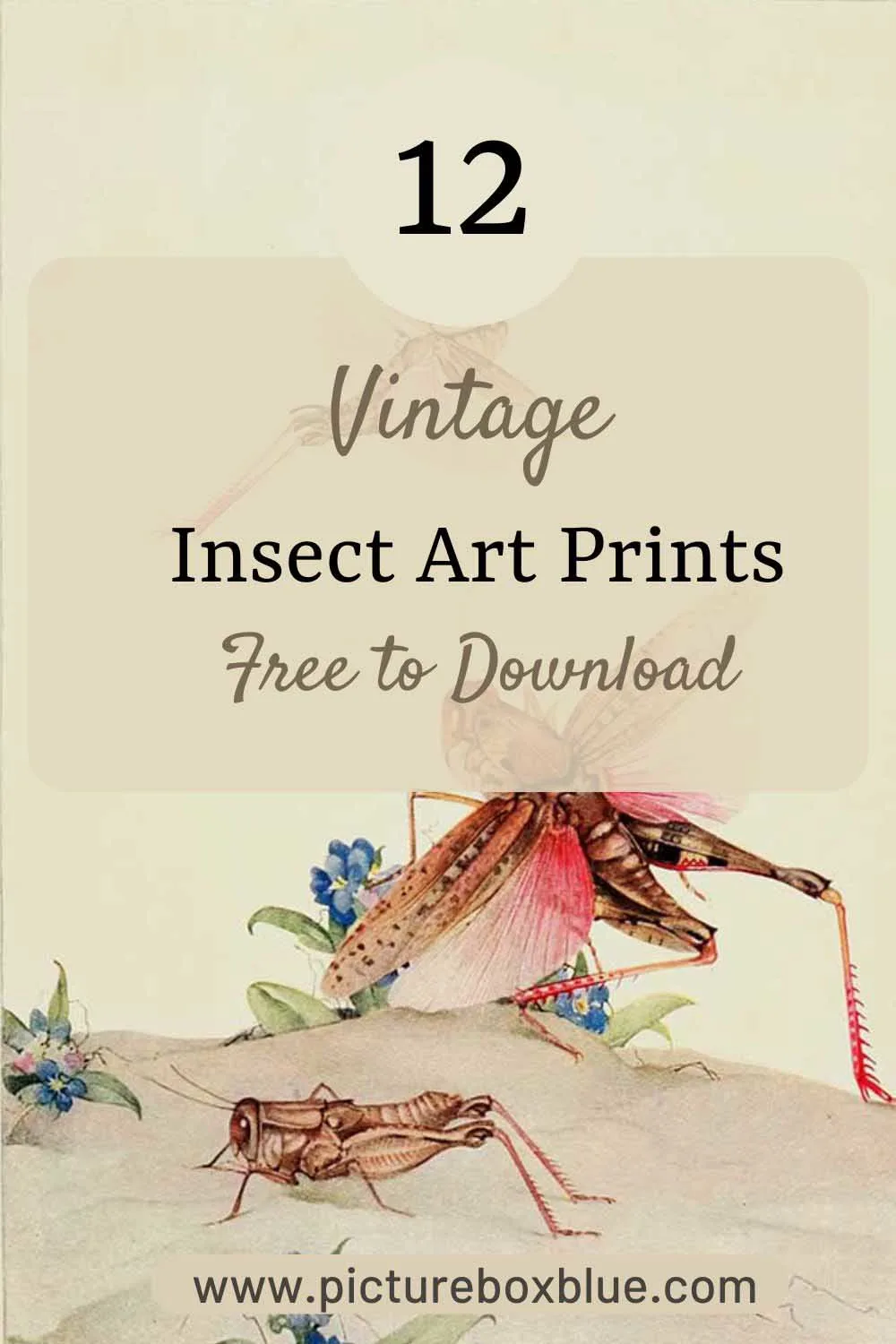
Why Fabre’s Work is Special
Jean-Henri Fabre was a renowned entomologist whose love for insects shone through in his work. His book, filled with meticulous observations and stunning illustrations, opened the hidden world of insects to the public. Fabre’s blend of scientific accuracy and artistic beauty makes his work timeless and captivating.
Often called the father of modern entomology, Fabre’s detailed studies of insect behaviour laid the groundwork for future research. His dedication to observing and documenting insect life was so intense that he often lived among the insects he studied, making his work incredibly detailed and accurate.
Fabre had a knack for turning scientific observations into engaging stories. His writing style is educational and entertaining, making complex scientific concepts accessible to everyone. Besides being an entomologist, Fabre was a botanist, physicist, and poet. His diverse interests allowed him to see and describe the natural world richly detailedly.
Charles Darwin admired Fabre’s work, calling him “an inimitable observer,”. Fabre’s home in Sérignan-du-Comtat, France, became his living laboratory. Today, it serves as a museum dedicated to his life and work, attracting visitors from around the world.
Fabre’s “Book of Insects” illustrations are scientifically accurate and works of art. The detailed and vibrant depictions of insects fascinate and inspire artists and scientists alike.
Fabre’s Book Of Insects Prints 1-6
Click on the title above the vintage insect painting you want to download. A higher-resolution image will open in a new tab. You can then save or print this image.
The Sacred Beetle, or dung beetle, fascinated Jean-Henri Fabre. He observed their diligent behaviour of rolling dung balls, which they use for food and laying eggs. Fabre admired their industrious nature and detailed their role in recycling nutrients into the soil.
He highlighted their importance in maintaining ecological balance and their remarkable navigational skills, often comparing their meticulous work to that of human labourers in his engaging and accessible writing style.
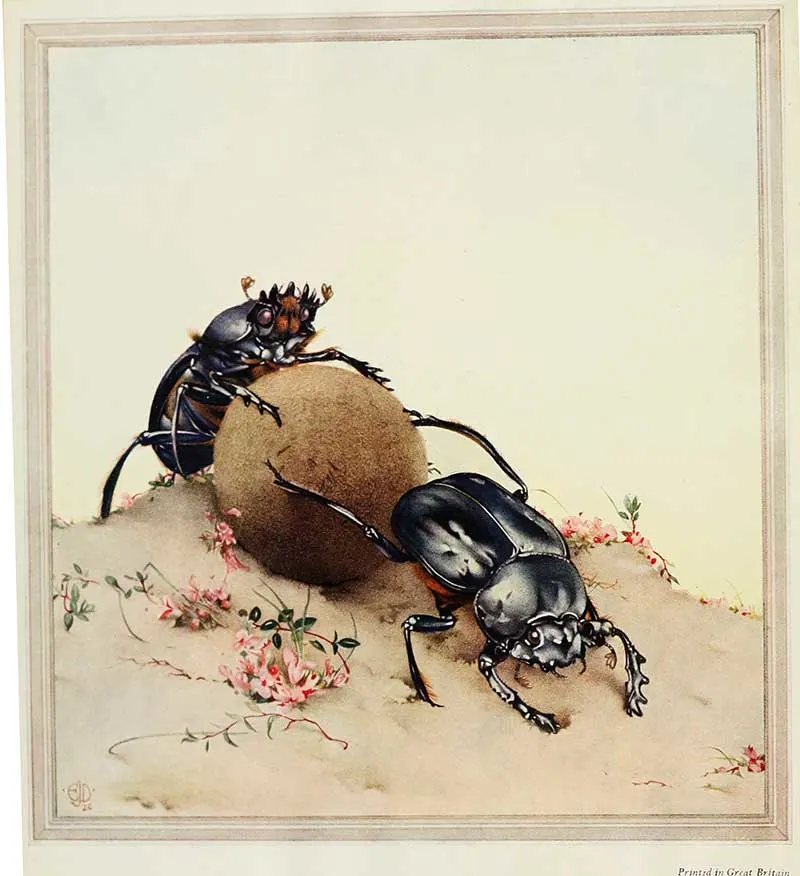
Jean-Henri Fabre was deeply fascinated with cicadas, marvelling at their life cycle and distinctive song. He described the cicada’s life underground, where it spends years as a nymph before emerging to the surface. Fabre admired their transformation into adults, singing loudly in the summer heat.
He detailed how their loud, continuous song is a mating call and a testament to their resilience in the scorching sun. Fabre’s vivid storytelling brings the cicada’s world to life, highlighting its unique place in nature and its extraordinary survival strategy.
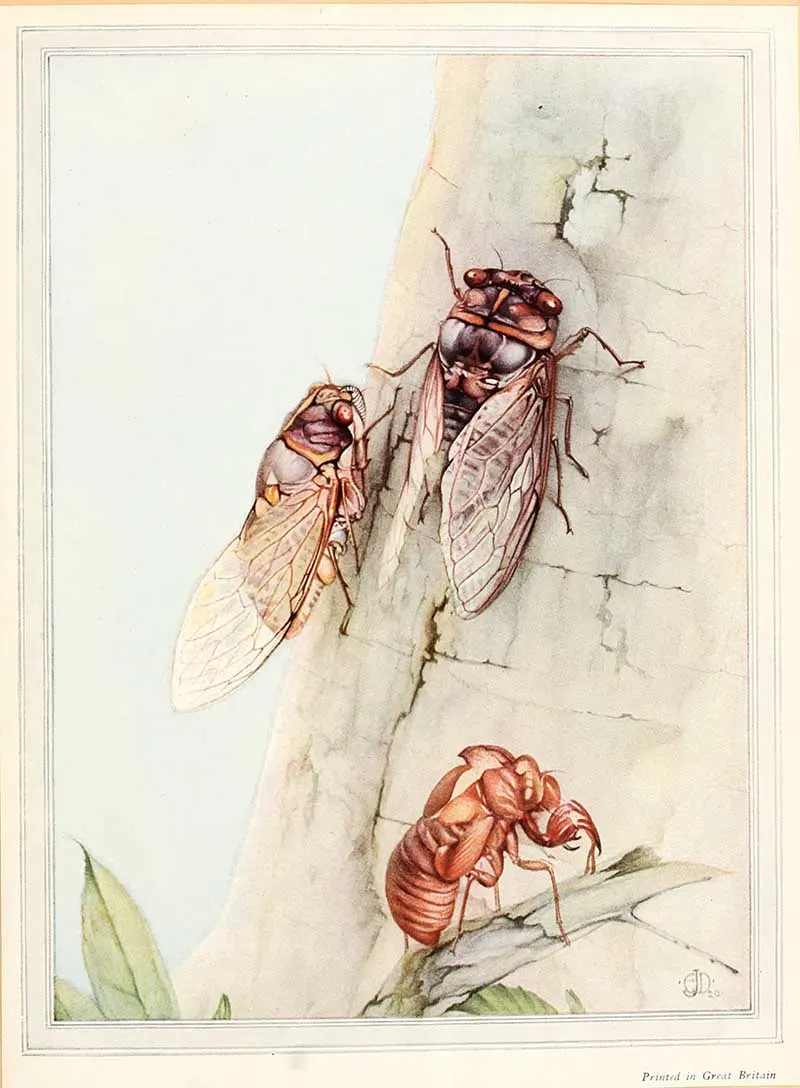
Jean-Henri Fabre was captivated by the Praying Mantis, often referring to it as a “ferocious and elegant predator.” He vividly described its hunting prowess, noting how it lies in wait with its forelegs poised, ready to snatch unsuspecting prey. Fabre admired its patience and precision, comparing its movements to a seasoned hunter’s. He also detailed the mantis’s life cycle, from the delicate hatching of eggs to the fierce battles between adults.
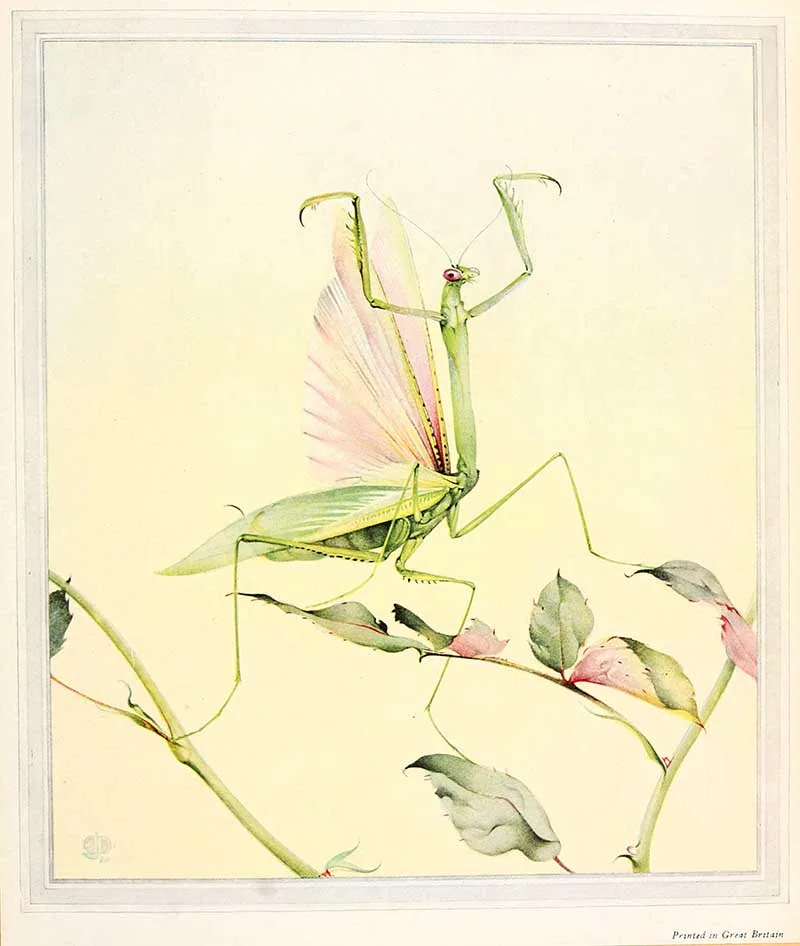
In Fabre’s Book of Insects, he was intrigued by the mason wasp and praised its incredible craftsmanship. He detailed how these industrious insects meticulously gather mud to construct their nests, creating intricate little chambers for their larvae.
Fabre admired their precision and skill, comparing their work to human builders. He also observed their diligent behaviour in stocking each chamber with paralyzed prey, ensuring a fresh food supply for their young.
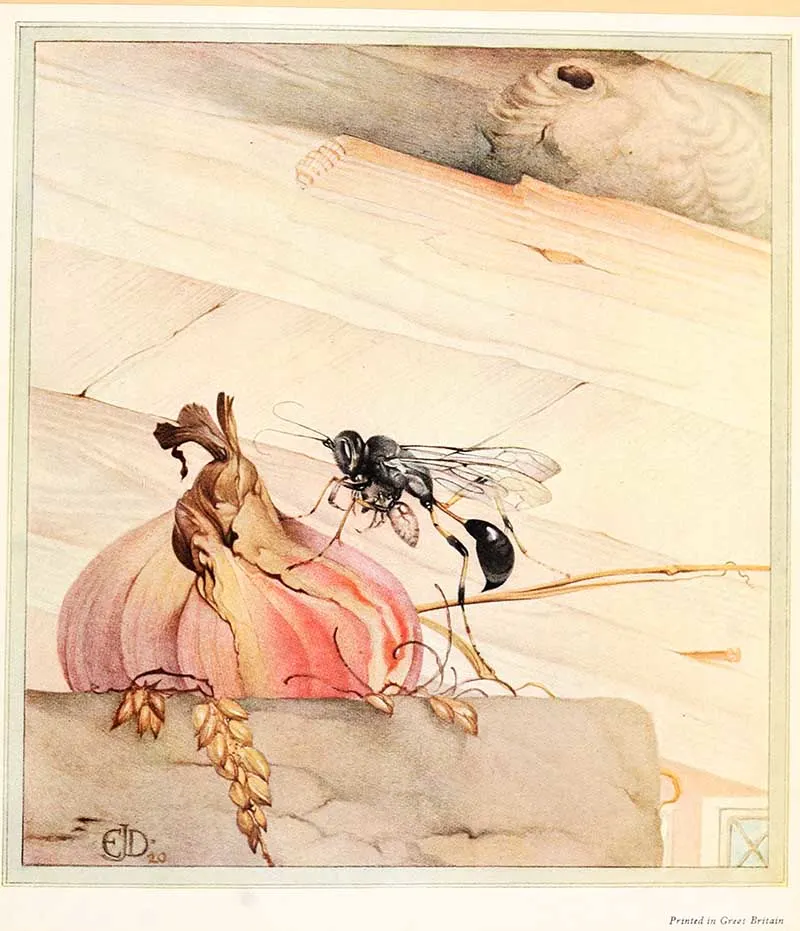
Fascinated by Psyche caterpillars or bagworms, Fabre detailed their unique behaviour of constructing protective cases from silk and surrounding debris. These tiny architects meticulously collect twigs, leaves, and other materials, crafting intricate mobile homes they carry. Fabre admired their ingenuity and the careful selection of materials, highlighting their adaptability and resourcefulness.
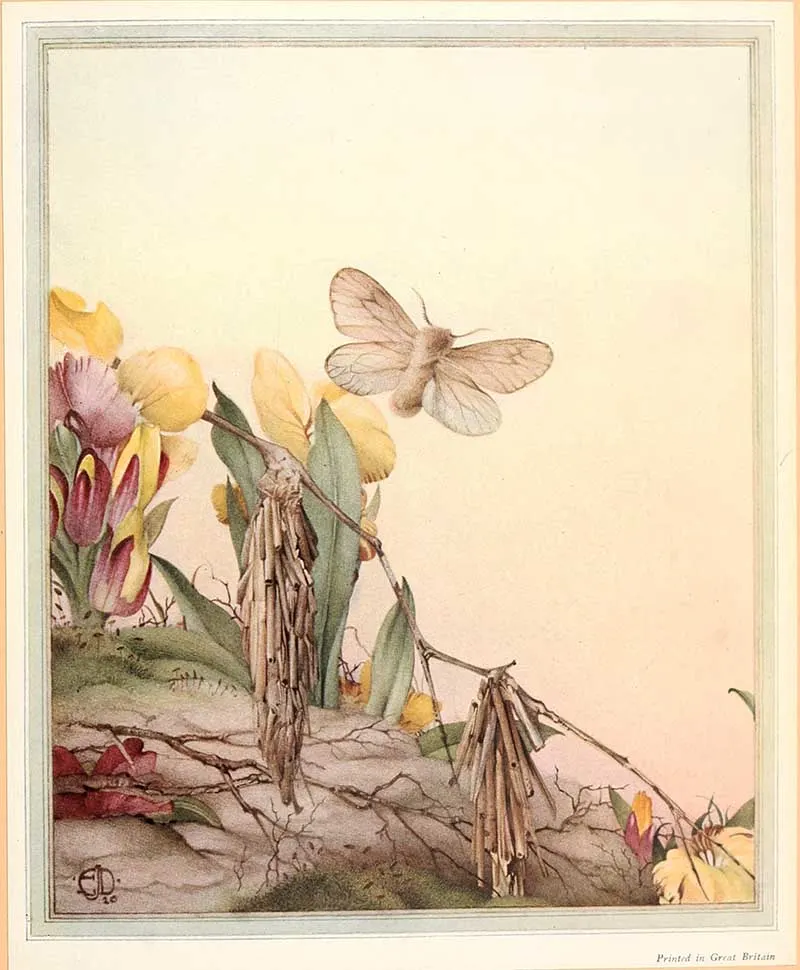
Fabre’s observations on the Spanish Copris, a type of dung beetle, highlight its remarkable behaviour and ecological role. He described how these beetles are efficient recyclers, diligently collecting and burying dung to create underground chambers.
The Spanish Copris impressively rolls dung balls and buries them to serve as food storage and nurseries for their larvae. Fabre admired their industrious nature and vital role in nutrient recycling and soil aeration.
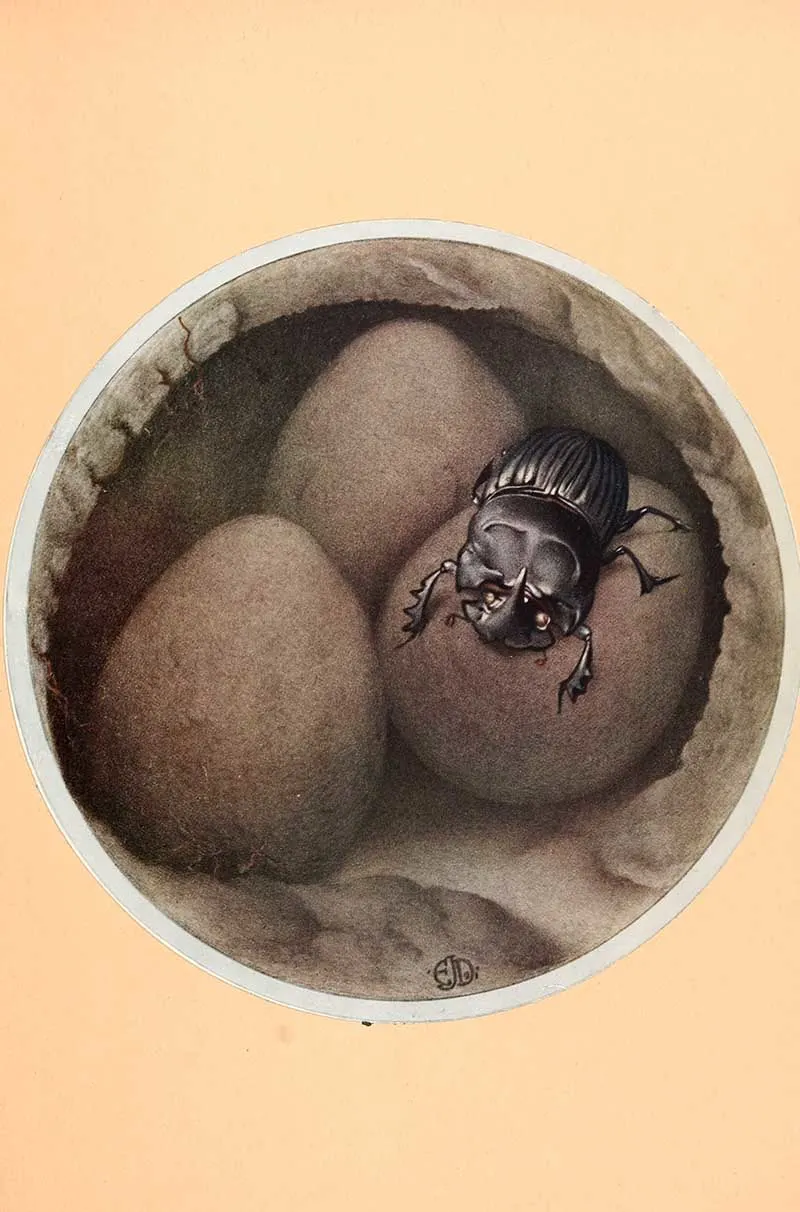
Fabre’s Book Of Insects Prints 7-12
Print 7: The White-Faced Decticus
In his writings, Fabre found the white-faced decticus, a type of large grasshopper, to be a fascinating subject. He described its powerful legs, which allow it to leap great distances, and its distinctive, almost musical stridulation created by rubbing its wings together. Fabre detailed the insect’s predatory habits, noting how it hunts smaller insects with precision and agility. He also admired its camouflage abilities, blending seamlessly into its grassy habitat.
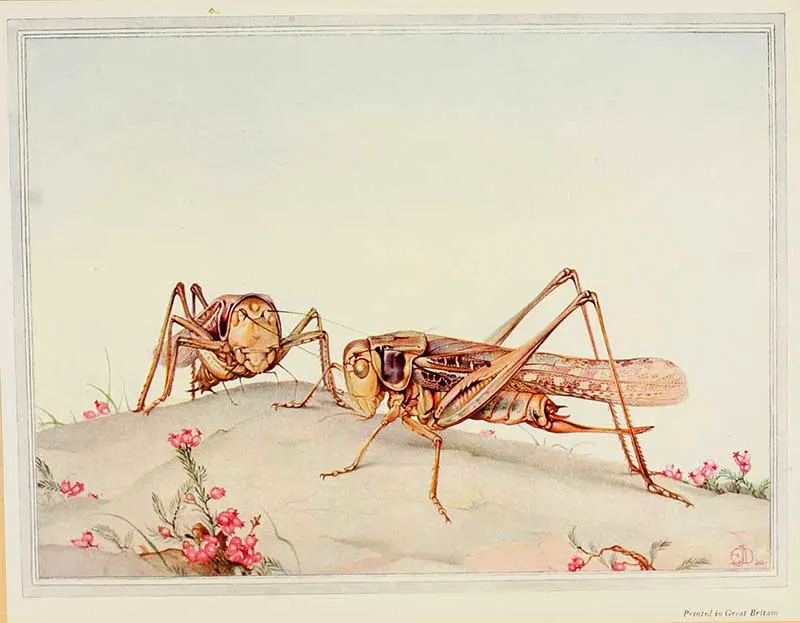
Fabre admired the common wap’s social structure and teamwork within the nest. He described how these wasps build intricate paper nests from chewed wood fibres mixed with saliva, showcasing their impressive engineering skills. He also noted their role as both predators and pollinators, capturing other insects to feed their larvae while aiding in pollination.
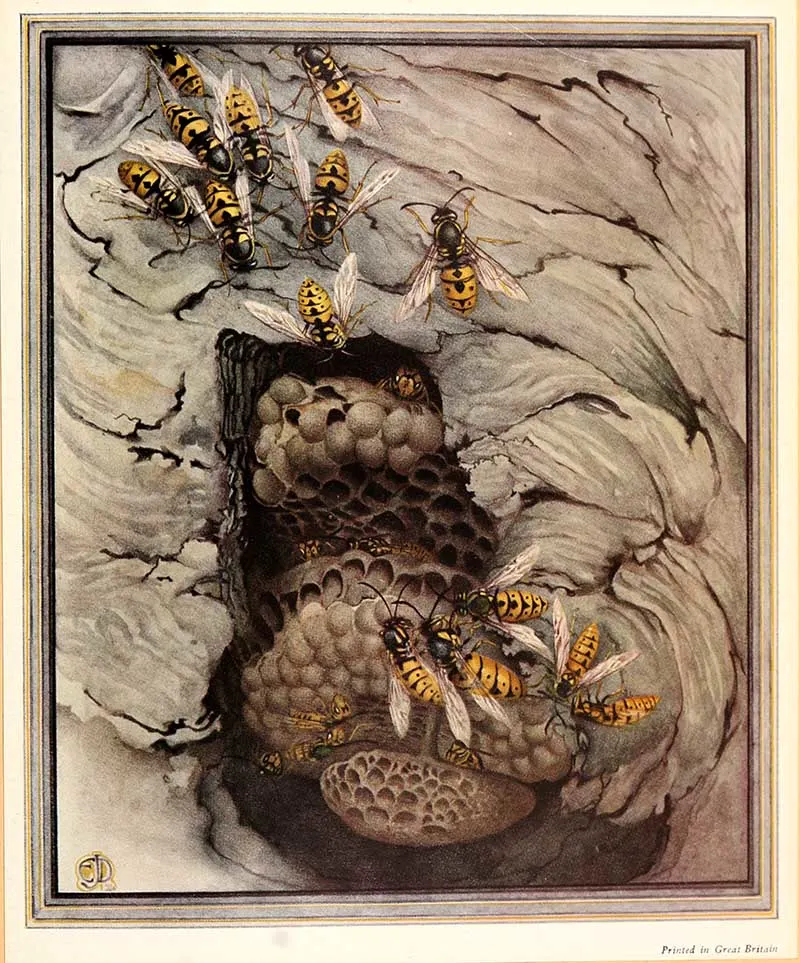
The field cricket, with its distinctive chirping, captivated Fabre. Males produce this sound by rubbing their wings together to attract mates. He detailed their burrowing habits, noting how they create intricate underground homes to escape predators and harsh weather. Fabre also found their territorial behaviour fascinating, as males fiercely defend their burrows from rivals.
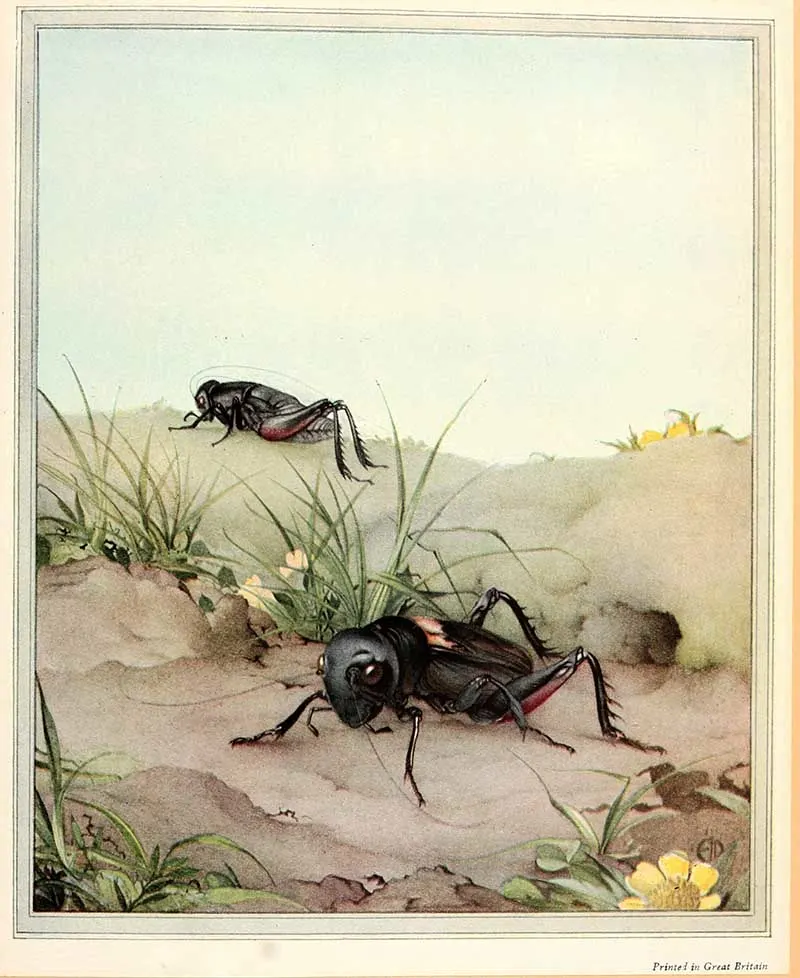
The Sisyphus, a dung beetle, intrigued Fabre with its industrious and almost mythic behaviour. He observed how these beetles, named after the Greek myth of Sisyphus, roll balls of dung much larger than themselves with incredible persistence and strength.
Fabre marvelled at their teamwork and dedication as they manoeuvre their prized dung balls to safe locations for feeding and breeding. His engaging narrative paints a vivid picture of their tireless efforts, drawing parallels to the eternal struggle of their namesake.
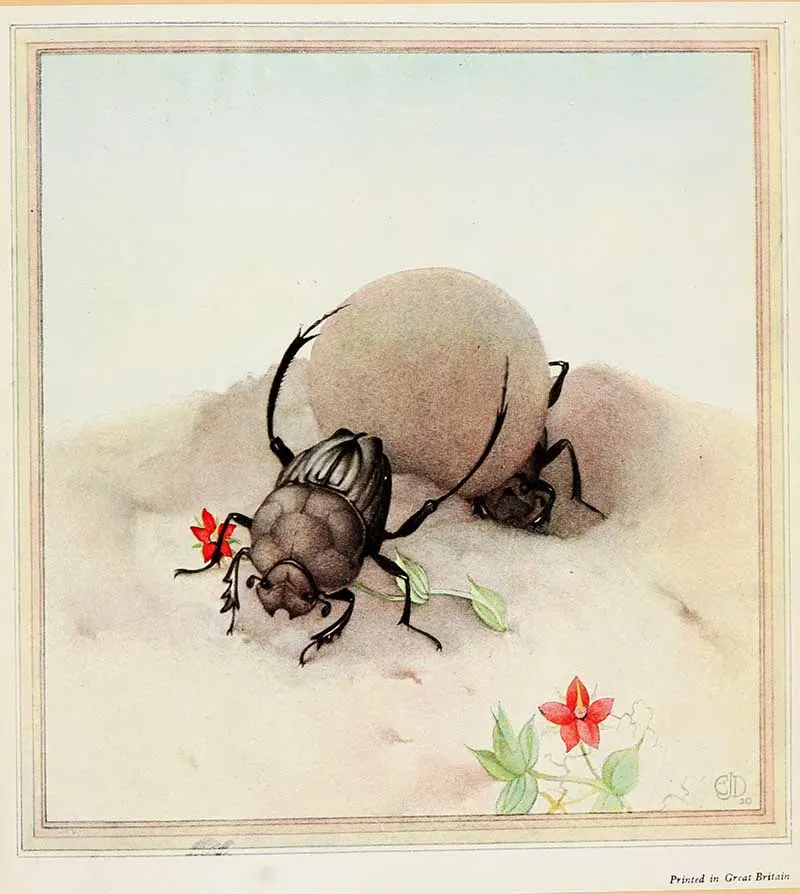
Italian locusts captivated Fabre with their swarming behaviour, capable of devastating crops as they migrated in large numbers. He detailed their resilience and adaptability, thriving in various environments and rapidly developing from nymphs into adults.
Fabre highlighted their life cycle, including egg-laying in the soil and the locusts’ significant impact on agriculture. His engaging narrative brings these insects’ fascinating and destructive nature to life, showcasing their remarkable survival strategies.
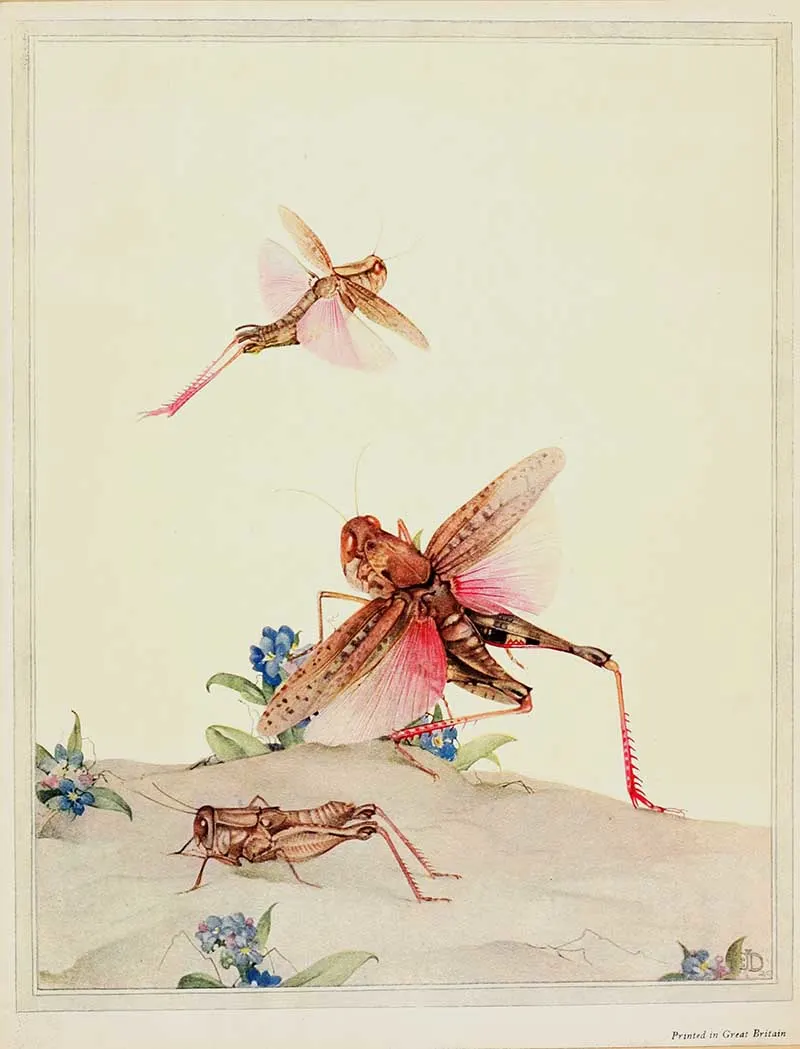
Fabre found the Anthrax fly fascinating, especially its sneaky lifestyle. He described how these flies lay their eggs in the nests of solitary bees. Once the larvae hatch, they chow down on the bee larvae, showing a ruthless way to survive. Fabre was amazed by their skill in finding and invading bee nests with such precision. His lively stories make this parasitic relationship sound like a tiny drama in nature, highlighting the Anthrax fly’s cunning and adaptability.
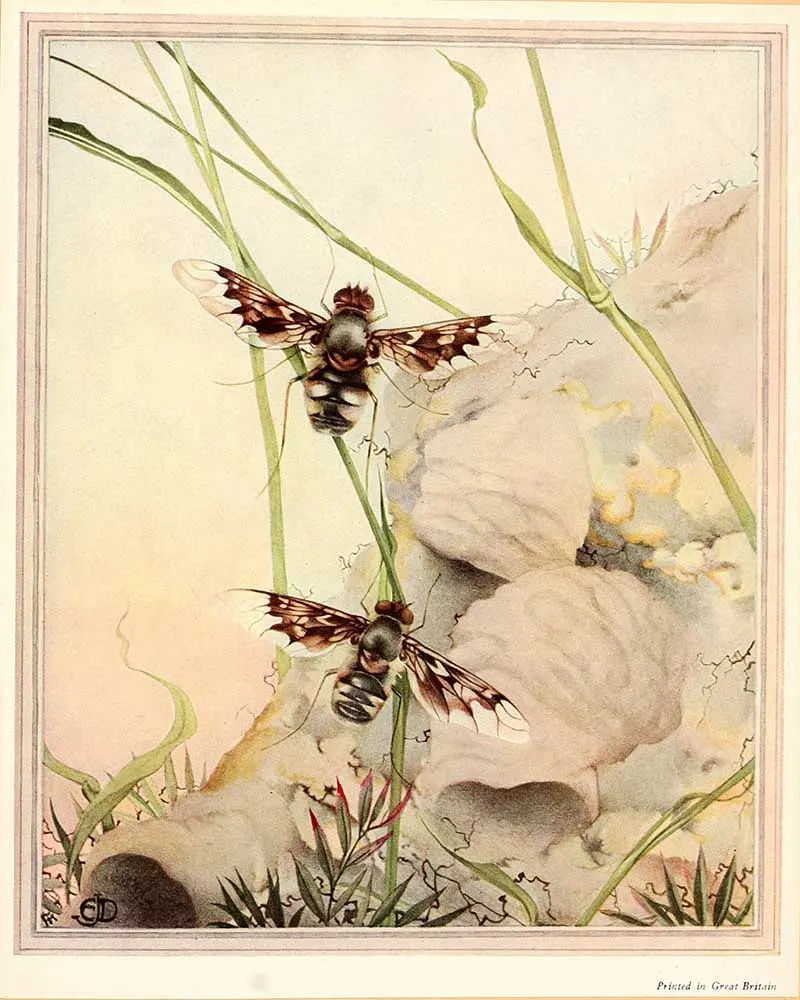
Conclusion & Other Related Prints
If you’re also fascinated by entomology and vintage art, Pictureboxblue is a treasure trove. In addition to Fabre’s Book of Insects illustrations, you’ll find E.A. Seguy’s Art Nouveau butterflies, Adolphe Millot’s insect posters, and collections of butterflies and dragonflies. These prints beautifully capture these incredible creatures’ delicate details and vibrant colours.
You’ll also find more insect art in Maria Sibylla Merian prints’ and Jan Brandes’s vintage nature illustrations.
While spiders are technically not insects, many people classify them as such. Here are equally fascinating and detailed spider illustrations that will captivate your interest.
Don’t forget to check out these fascinating vintage entomology prints, featuring lots of beautiful beetles.
If you fancy, you can Buy Me A Coffee Here.

Michelle
Sunday 14th of July 2024
Wow! Who knew insects could be so stunning?
claire
Sunday 14th of July 2024
Yes, I thought the same. The paintings are lovely.